Each year, approximately 17.3 million American adults experience a major depressive episode. Recognizing the prevalence of depression and who the disorder affects can raise awareness of its dangers.
Depressioninvolves experiencing negative emotions such as sadness, grief, low self-esteem and hopelessness. Depressed states can occur spontaneously due to chemical imbalances, in connection with othermental health conditions, such as anxiety, or following a negative incident.
Various events can cause depression. The death of a family member, breaking up with a romantic partner, getting fired from a job, ending a friendship or havingfinancial strugglescan all result in overwhelming sadness and persistent, negative thoughts. For some people, depression is genetic or hereditary and not due to an adverse event.
The many different ways that people develop depression helps explain why it’s so common. According to theAnxiety and Depression Association of America, approximately 322 million people in the world live with depression. Otherdepression statisticsinclude which demographics are most affected by this mental health condition and how many people receive treatment for it. Learningdepression facts and statisticscan help people better understand this condition.
Who Is Affected by Depression?
According to the Substance Abuse and Mental Health Services Administration’s (SAMHSA)2017 National Survey on Drug Use and Health, approximately 17.3 million American adults experienced a major depressive episode within the previous year. The Diagnostic and Statistical Manual of Mental Disorders, 5th edition (DSM-5) defines amajor depressive disorderas experiencing a depressed mood, or loss of interest or pleasure in daily activities, for at least two weeks at a time.
Treatment Can Be Life Changing. Reach out today.
Whether you are struggling with addiction, mental health or both, our expert team is here to guide you every step of the way. Don’t wait— reach out today to take the first step toward taking control of your life.
Depressioncan affect any person regardless of their gender, age, race or background. However, specific demographics have higher rates of prevalence. Somerisk factors for depressionconnect the illness to a person’s gender or age.
Among the 17.3 million Americans who reported having a major depressive episode in 2017:
- Around 11 million were female and 6 million were male
- Young adults between the ages of 18 and 25 had higher rates of depression
- In every age group, females were more likely than males to struggle with depression
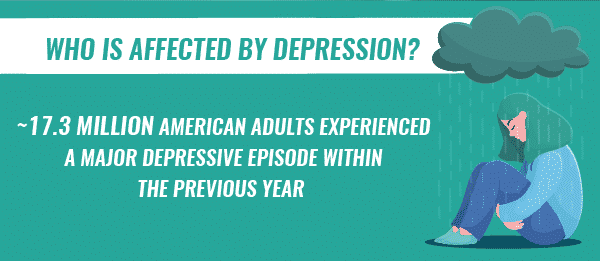
Depression Risk Factors For Women
According to the American Institute of Stress, therisk factors for depressionamong females include:
- Genetics
- Persistent hormonal changes that lead to depressive states
- Societal challenges such as unequal pay and unfair gender roles
Some races and employment types also have a higher prevalence of depression. White American adults comprised 70 percent of the 17.3 million who reported a major depressive episode. The next-highest figures by race were for Hispanic and Latino (around 13 percent) and Black (around 8 percent).
Approximately 7.2 million Americans who identified as having full-time employment reported experiencing a major depressive episode. However, unemployed Americans had the highest rate of depression at 10.8 percent. Therisk factors for depressionamong people who are unemployed or have part-time employment include having difficulties paying bills and uncertainty about their financial stability.
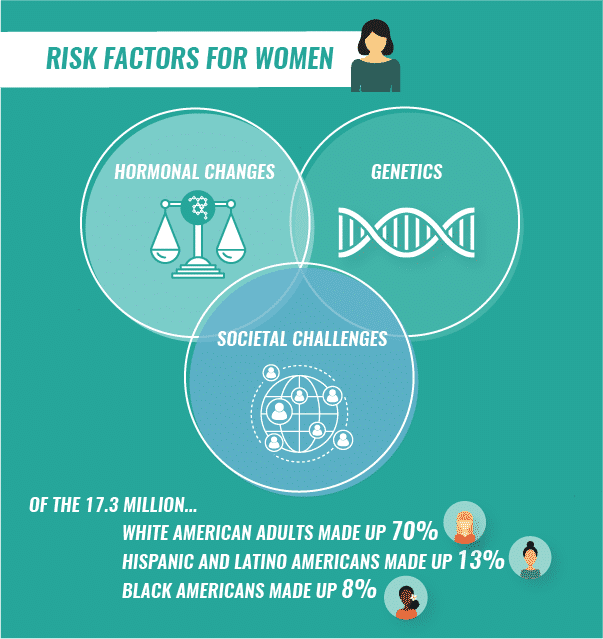
Depression Among Adults
The number of cases ofdepression in adultsincreases each year. The total number of American adults with the condition rose by 1 million people from 2016 to 2017. In most of the adult age groups, rates of depression increased year to year. Senior age groups are no exception.
Depression Among Older Adults
According to the 2017 survey, approximately 1.4 million Americans age 65 and older experienced a major depressive episode. In 2016, the figure was 1.3 million. Some factors explaining the increase indepression among older adultsinclude:
- The death of a loved one
- Lifestyle changes due to retirement
- Becoming physically ill
- Anticipating death
Depression in Young Adults
For every other age group, including the individual ages between 18 and 25, depression rates increased.Depression in young adultsis a significant problem in the United States. Adults between ages 18 and 25 have a higher percentage, 13.1 percent, of having a major depressive episode than any other age group. The age that depression affects most is 20. Of Americans who are 20 years old, 15.8 percent experienced a major depressive episode within the year before taking the survey.
Explanations as to why young adults experience depression include:
- Societal pressures
- Peer pressure
- Academic pressures
- Stress-related to difficulty finding full-time employment
- Challenges in social life
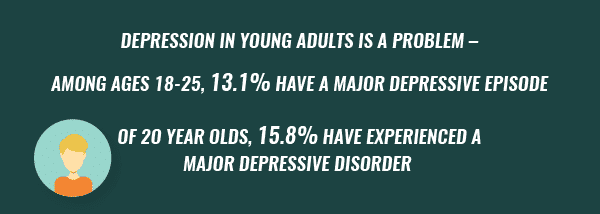
Depression in Children and Teens
Mental Health America reports thatteen depressionis also rising and is higher thandepression in young adults. The website states that 1 in 5 teenagers in America struggles with clinical depression. Academic, social and family difficulties all factor intowhy adolescents develop this condition.
For young adults, depression is common in part due to academic and social pressure. For example, most young adults use social media to interact with friends and other peers.Medical sources revealedthatsocial media and depression are connected, which puts people who use Facebook, Twitter and other mediums at risk of developing a mental health issue. Economic instability also causes depression as young adults face challenges finding and maintaining full-time employment.
Depression in childrenand teenagers can show itself in various forms, including:
- Increased anger or irritability
- Difficulty focusing at school
- Changes in sleeping or eating habits
- Expressing feelings of worthlessness or inferiority compared to peers
- Lacking energy
- No longer being interested in social activities or recreational hobbies
- Suicidal thoughts
Addressingteen depressioncould decrease the prevalence of the mental disorder in older demographics. Receiving treatment at a young age — and learning coping mechanisms from therapy — may prevent severe forms of depression in adulthood.
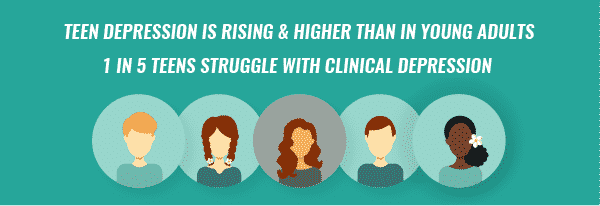
Prevalence of Different Types Depression
The 17.3 million adults who experience a major depressive episode each year reveals theprevalence of depressionin America. However,depression ratesvary when focusing on specific types of depression. Aside from major depressive disorder, two of the more common types of depression are seasonal depression and postpartum depression.
Feelings of depression or anxiety can lead to suicidal thinking.If you or a loved one is experiencing suicidal thoughts or tendencies, call theNational Suicide Prevention Hotlineat1-800-273-8255.
Major Depressive Disorder
Major depressive disorder, also called clinical depression, is the most common and severe type of depressive condition. Major depressive disorder can cause severe impairment in a person’s daily functioning. Theprevalence of major depressive disordercontinues to increase in America.
Some statistics on majordepressive disordershow how often the condition affects people’s quality of life. Across all demographics, more than half of the people who reported having a major depressive episode also said they suffered from severe impairment due to their depression. TheSAMHSA national surveydefines severe impairment as the highest level of impairment across four areas: home management, work, relationships with close friends or family members, and social life.
Of the 17.3 million Americans who reported having a major depressive episode, approximately 11 million also reported having a severe impairment. Nearly twice as many females as males (7.2 million compared to 3.8 million) said they had a major depressive episode along with severe impairment.
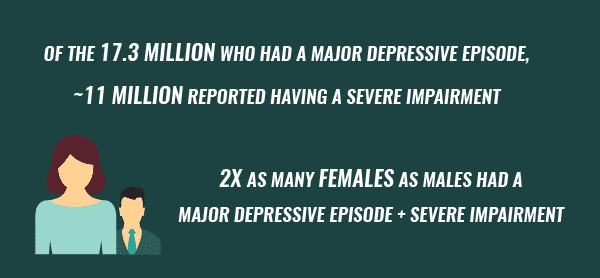
Seasonal Depression
Seasonal depression, also known asseasonal affective disorder, is a mood disorder that occurs during the same time each calendar year. According to theNational Institute of Mental Health, seasonal depression usually begins in late fall or early winter and ends in late spring or early summer.
Geography influences the development of seasonal depression. According to the National Institute of Mental Health, locations further from the equator are more likely to experience a higher prevalence of seasonal depression among their populations than areas closer to the equator. This occurrence is due to decreased sunlight during winter months, which can lower a person’s serotonin levels and cause depressed states.
Some noteworthyseasonal depression statistics, according toMental Health America, include:
- Approximately 5 percent of the U.S. population experiences seasonal depression each year
- Around 80 percent of people with this depressive disorder are female
- Age of onset usually occurs between 20 and 30
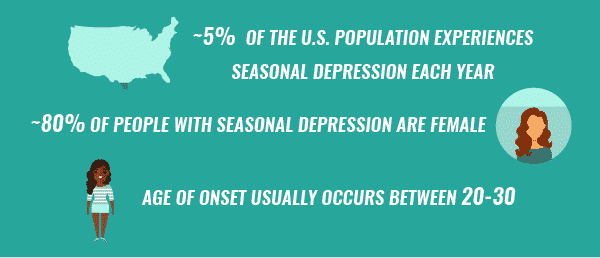
Postpartum Depression
Postpartum depressionis a mental condition that occurs following childbirth. According toPostpartumDepression.org, between 10 and 20 percent of new mothers experience this depressive disorder.
Additionalpostpartum depression statisticsinclude:
- Approximately 1 in 7 women (or 600,000 women) may experience the condition within a year after giving birth
- An estimated 300,000 women who miscarried or had a stillbirth suffer from postpartum depression each year
- Between 70 and 80 percent of new mothers will experience whatPostpartumDepression.orgcalls the “baby blues,” which is a less severe form of the clinical disorder
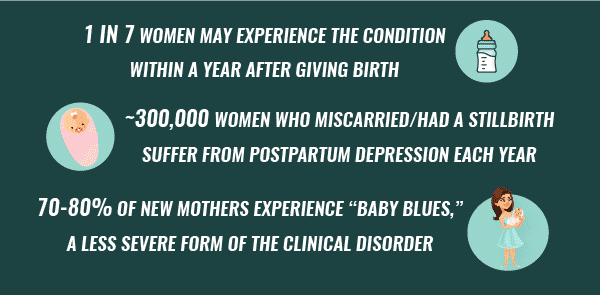
Rates of Depression and Co-Occurring Conditions
Depression often co-occurs with other conditions, such as psychological disorders orsubstance abuse and addiction. Anxiety and depression frequently co-occur due to shared symptoms and causes. According to theAnxiety and Depression Association of America, nearly half of the people diagnosed with depression also have ananxiety disorder.
Other conditions that frequently co-occur with depression includebipolar disorder,post-traumatic stress disorderand specificpersonality disorders.
Depression also links to medical issues such as heart disease and stroke.Mental Health Americalists noteworthy statistics involving depression as a co-occurring condition:
- Between 40 and 65 percent of people who had a heart attack also experienced depression
- Depression occurs for between 10 and 27 percent of people who survived a stroke
- Approximately 25 percent of people with cancer also have depression
- Around 1 in 3 people with depression also have a substance use disorder
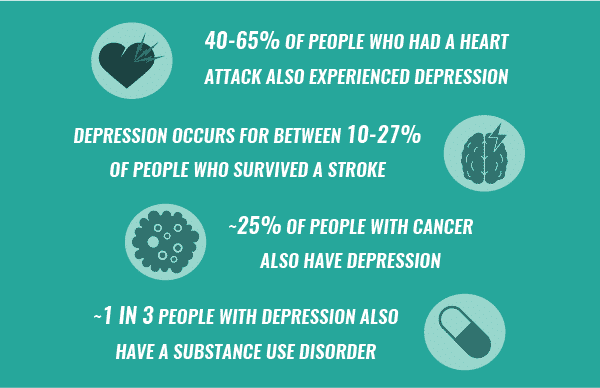
Diagnosing Depression
The DSM-5 is a helpful resource fordiagnosing depression.According to the DSM-5, for someone to have clinical depression, they must have depressive episodes that last at least two weeks. Depending on the type of depressive disorder, there might be additional criteria to receive a clinical diagnosis.
Approximately 17.3 million American adults reported having a major depressive episode in 2017. However, thenumber of depression cases in Americais most likely higher due to the lack of awareness and stigma associated with the condition and seeking treatment.
Decreasing the stigma surrounding depression can start with:
- Depression screening, which aids in early intervention and treatment of depression
- Speaking upabout depression
- Understandinghow to talk to loved ones about depression
Economic Impact of Depression
Depression is theleading cause of disability worldwide, and this condition has a significant impact on the American workforce and economy. According to theCenter for Workplace Mental Health, between 6 and 7 percent of full-time workers experience major depressive disorder each year.
The organization estimates theeconomic impact of depressionto be $210 billion per year. Factors contributing to this huge figure include:
- Absenteeism: missed days from work
- Presenteeism: reduced productivity at work
- Medical costs: pharmacy costs and inpatient or outpatient medical services
Together, absenteeism and presenteeism comprise nearly half of the $210 billion annual employer expenditures, while medical costs comprise 45-47 percent of this figure. Approximately 5 percent of this figure is expenditures related to employee suicides.
Statistics on Depression Treatment
As awareness of the prevalence of depression increases, more people are seeking treatment. More than half of the 17.3 million American adults who reported having a major depressive episode in 2017 also said they receivedtreatment for their depression. Specificdepression treatment statisticsinclude:
- Approximately 67 percent of people who had a major depressive episode said they received treatment
- Around 72 percent of people who had a major depressive episode and a severe impairment said they received treatment
- The percentages of people who had a major depressive episode and received treatment rose from 2016 to 2017 in both genders, most age groups, all races and every employment type
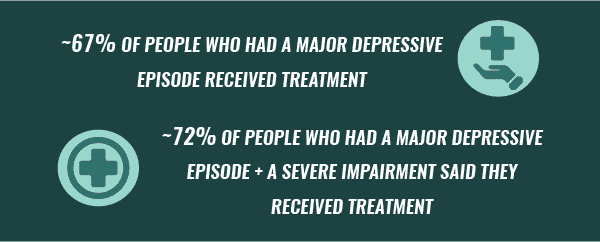
Depression recovery statisticsmay not offer the clearest picture of how the disorder affects people. Due to the nature of depressive conditions, there is no absolute cure, but ongoing treatment and therapy can mitigate depressive symptoms.
After receiving treatment for depression, people may experience diminished symptoms and improved moods due to effectiveantidepressant medicationsor coping mechanisms. However, the symptoms of a depressive disorder can return later in the person’s life and require additional treatment if treatment stops.
Understanding how prevalent the condition is and accepting medical assistance will help people manage their depression effectively. Deciding to receive treatment for depression is a significant step toward improved mental health.
Related Topic:High functioning depression treatment
If you or a loved one struggles withdrug or alcohol abuse and co-occurring depression, The Recovery Village can help. Ourdual-diagnosis programstreat addiction and mental health conditions simultaneously.Call todayto learn more about compassionate treatment options.






